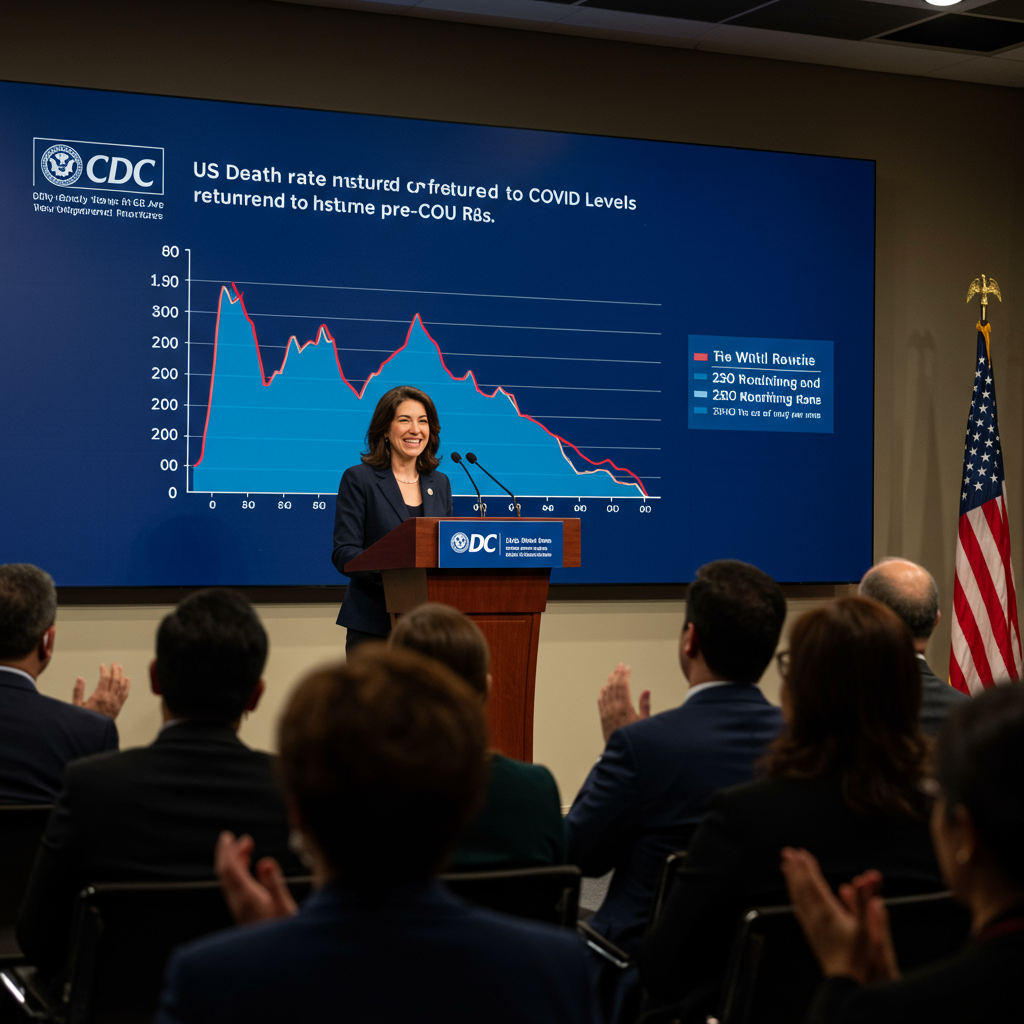A significant public health turning point has arrived: the overall US death rate in 2024 has successfully reverted to levels last seen before the disruptive COVID-19 pandemic. According to a landmark report from the US Centers for Disease Control and Prevention (CDC), this encouraging decline signals a critical shift in the nation’s health landscape. For the first time since its devastating emergence, COVID-19 has fallen out of the top ten leading causes of death, marking a pivotal moment in America’s recovery and ongoing health challenges.
This latest provisional data offers a cautiously optimistic outlook, highlighting both progress and persistent disparities. While the nation celebrates a return to pre-pandemic mortality patterns, new and existing public health crises, from drug overdoses to rising infant mortality and specific infectious diseases, demand continued vigilance and targeted interventions.
America’s Health Rebounds: The 2024 Mortality Milestone
The US death rate has shown remarkable improvement. After peaking in 2021 at approximately 880 deaths for every 100,000 people—a direct consequence of the pandemic’s initial surge—the age-adjusted death rate has plummeted by an estimated 18% since then. A substantial 4% drop last year alone pushed the national mortality rate down to its lowest point since 2019.
For 2024, the CDC’s National Center for Health Statistics reported 722 deaths per 100,000 people across the United States, accounting for nearly 3.1 million lives lost overall. While this data remains provisional, it is highly robust, based on 99.9% of all 2024 death records processed by June 1, 2025. This comprehensive snapshot underscores a profound, positive shift in national health trends, even as underlying challenges persist.
COVID-19’s Retreat from the Top Killers
The decline of COVID-19 as a leading cause of death is arguably the most striking revelation. The virus, which swiftly ascended to become the third leading cause of death in 2021, responsible for roughly 460,000 fatalities, has steadily receded. By 2022, it was the fourth leading cause (245,614 deaths), and by 2023, it fell to tenth (76,446 deaths). In 2024, despite still contributing to tens of thousands of deaths, COVID-19 is no longer among the top ten, a testament to vaccination efforts, improved treatments, and population immunity.
However, its departure from the top ten does not mean a clear path for other health issues. Long-standing health burdens continue to dominate the mortality landscape. Heart disease and cancer collectively remain the most significant threats, accounting for over 40% of all deaths in 2024. Specifically, heart disease led with 683,037 deaths, followed closely by cancer with 619,812 fatalities.
Navigating Complex Public Health Challenges
While COVID-19’s shadow has lessened, other urgent health crises demand attention. The top ten leading causes of death in the US for 2024 illustrate a complex tapestry of ongoing health battles:
- Heart disease
- Cancer
- Unintentional injury
- Stroke
- Chronic lower respiratory diseases
- Alzheimer’s disease
- Diabetes
- Kidney disease
- Chronic liver disease and cirrhosis
- Suicide
Among these, the category of “unintentional injury,” which notably includes drug overdoses, presents a nuanced picture of both progress and persistent challenges.
The Evolving Landscape of Drug Overdose Deaths
For the third consecutive year, unintentional injuries, predominantly driven by drug overdoses, ranked as the third leading cause of death in 2024, causing 194,488 fatalities. Yet, within this category, there’s an unprecedented, albeit cautiously celebrated, development: the United States saw a significant 27% decline in drug overdose deaths in 2024. Provisional data points to an estimated 80,391 fatalities, the lowest annual total since 2019, reversing a surge observed during the pandemic.
This national decline is largely attributed to a substantial decrease in deaths involving fentanyl, a potent synthetic opioid. Fentanyl-related fatalities dropped from over 76,000 in 2023 to just over 48,000 in 2024. Experts suggest this positive trend stems from several factors, including the widespread availability of naloxone (an opioid overdose reversal drug, now over-the-counter), expanded access to addiction medications, and heightened public awareness of opioid dangers. Many states, including Louisiana, Michigan, Ohio, and West Virginia, reported declines of 35% or more.
Persistent Disparities and Emerging Threats in Substance Use
However, the picture isn’t uniformly bright. The crisis continues to evolve. While fentanyl deaths decreased, fatalities involving stimulants, especially methamphetamine, saw a concerning rise from 29,456 to 37,096. Cocaine-linked deaths also increased by approximately 8,000, reaching 30,833. This highlights a critical gap in treatment, as no FDA-approved medications currently exist for stimulant use disorders.
A deeper regional analysis, such as a study from Kentucky published in Injury Epidemiology, reveals that despite a state-level decline, 2024 overdose rates in Kentucky remained significantly higher than pre-pandemic 2019 levels for specific vulnerable populations. Males, Black residents, individuals aged 55 and older, those in non-metropolitan counties, and residents of lower-income communities all experienced sustained increases. Only adults aged 25-34 saw a decrease. Moreover, while fentanyl involvement returned close to pre-pandemic levels in Kentucky, psychostimulant-involved overdose deaths, particularly cocaine, surged by 73% since 2019. These findings underscore the urgent need for targeted, culturally sensitive public health initiatives that address diverse drug use patterns and persistent health inequities. Alarmingly, states like Alaska continue to see opioid overdoses, driven by fentanyl, reach historic levels.
Unpacking Other Critical Health Indicators
Beyond the major causes, the CDC report sheds light on several other crucial public health trends that impact overall mortality.
The Alarming Rise of Suicide Rates
Amidst the shifting landscape, suicide has tragically re-emerged as a significant concern, moving up to the tenth leading cause of death in 2024, with nearly 49,000 lives lost. This follows a record high in 2022, with only slight decreases since. The 988 Suicide & Crisis Lifeline has seen millions of calls, texts, and chats since mid-2022. However, the discontinuation of specialized support for LGBTQ+ youth, which routed about a tenth of individuals to a subnetwork, represents a setback in addressing the needs of particularly vulnerable populations.
Enduring Disparities and Stalled Progress for Our Youngest
While death rates generally decreased across most age groups in 2024, they remained stubbornly steady for children aged 5 to 14 and, critically, for infants. This lack of progress for the youngest Americans is deeply concerning.
Infant mortality, after decades of decline, spiked in the US in 2022 and has yet to recover. In 2024, nearly 20,000 babies died before their first birthday, representing about 5.5 deaths for every 1,000 infants. This crisis led Mississippi to declare a public health emergency over its rising infant mortality rates last August.
Adding to the concerns for young populations, data on pertussis (whooping cough) reveals a significant increase in 2024. Preliminary figures show more than six times as many cases reported compared to 2023, surpassing pre-pandemic levels from 2019. This highly contagious respiratory illness poses the highest risk for severe disease and death in infants under one year old, whose immune systems are still developing. While vaccination is key, waning protection and resumed social contact mean that pertussis will likely continue to challenge public health efforts, particularly for vulnerable infants.
Persistent Inequities in Mortality
Despite an overall decrease in age-adjusted death rates across all racial and ethnic groups in 2024, vast disparities endure. Rates remained highest among the Black population, with over 924 deaths for every 100,000 Black individuals in the US – a staggering 28% higher than the overall national rate. Similarly, while mortality rates decreased for both men and women, the rate for men remained significantly higher than for women, underscoring persistent gender-based health disparities. Addressing these deeply rooted inequities requires multifaceted, systemic public health interventions.
Frequently Asked Questions
What is the US death rate for 2024, and how does it compare to pre-pandemic levels?
The age-adjusted US death rate in 2024 was 722 deaths per 100,000 people, marking its lowest point since 2019. This represents a significant return to pre-pandemic mortality levels, following a peak of 880 deaths per 100,000 in 2021. Critically, COVID-19, which drove much of the pandemic’s excess mortality, has fallen out of the top ten leading causes of death for the first time since its emergence, indicating a major public health milestone.
Which causes of death saw significant changes in 2024, and what resources are available for at-risk populations?
In 2024, drug overdose deaths saw a remarkable 27% national decline, largely due to decreased fentanyl fatalities and increased access to naloxone and addiction medications. However, deaths from psychostimulants like methamphetamine and cocaine increased. Suicide also rose to the tenth leading cause. For those struggling with substance use, resources include local addiction treatment centers and harm reduction programs; for mental health support, the 988 Suicide & Crisis Lifeline offers immediate assistance.
What are the key public health challenges remaining despite the overall death rate decline?
Despite the encouraging overall decline, significant challenges persist. The data reveals alarming disparities in mortality rates, with Black populations and men experiencing disproportionately higher rates. Infant mortality remains unrecovered from a 2022 spike, and infectious diseases like pertussis are on the rise, posing a particular threat to infants. Furthermore, while overall overdose deaths are down, the increase in stimulant-related fatalities and persistent regional disparities in the overdose crisis (e.g., in Kentucky and Alaska) demand specific, targeted public health interventions and policy changes.
Looking Ahead: Sustained Efforts for a Healthier Nation
The CDC’s 2024 mortality report offers a much-needed breath of fresh air, confirming a significant step towards national health recovery. The return to pre-pandemic death rates and COVID-19’s exit from the top ten leading causes are powerful indicators of progress. However, this moment is not a signal to relax. Instead, it underscores the urgent need to redirect and intensify public health efforts toward enduring and emerging crises.
Addressing the complexities of the drug overdose epidemic, supporting mental health, reducing stark health inequities, and safeguarding the health of our most vulnerable populations—especially infants—must remain at the forefront of the public health agenda. By leveraging data-driven insights and investing in targeted, equitable interventions, the United States can continue its journey toward a healthier, more resilient future for all its citizens.




